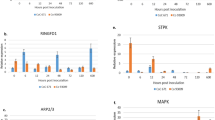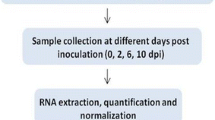Abstract
Detailed studies were taken up on host pathogen interaction between sugarcane and Colletotrichum falcatum causing red rot at the transcription level with a set of sugarcane varieties varying in disease resistance. A set of gene specific primers were designed to detect transcripts of resistance gene analogues (RGA’s), defense-related genes, transcription factors and signaling pathway genes induced during the host-pathogen interaction. mRNA extracted from pathogen inoculated canes at different time intervals were screened with 50 primers. Many of the transcripts were found to be expressed from the time of inoculation till 48h However, differential gene expression was found only for chitinase, metallothionein, R30 (RGA), receptor protein kinase, reversibly glycosylated protein and signal sequence hydrophobic region (SSHR) between resistant and susceptible varieties. Additionally differences in transcript size were noticed for some of the screened primers. We have standardized differential display (DD)-RT-PCR protocol with silver staining method to identify differential transcripts. Work on transcriptional variation in C. falcatum-sugarcane interaction has been performed for the first time and this promises a new approach to identify gene(s) involved in red rot resistance in sugarcane.
Similar content being viewed by others
References
Basson AE, Dubery IA (2007) Identification of a cytochrome P450 cDNA (CYP98A5) from Phaseolus vulgaris, inducible by 3,5-dichlorosalicylic acid and 2,6-dichloro isonicotinic acid. J. Plant Physiol. 164: 421–428.
Borras-Hidalgo O, Thomma BPHJ, Cannona E, Borroto CJ, Pujol M, Arencibia A, Lopez J (2005) Identification of sugarcane genes induced in disease-resistant somaclones upon inoculation with Ustilago scitaminea or Bipolaris sacchari. Plant Physiol. Biochem. 43: 1115–1121.
Carmona E, Vargas D, Borroto C J, Lopez J, Fernández A I, Arencibia A, Borrás-Hidalgo (2004) cDNA-AFLP analysis of differential gene expression during the interaction between sugarcane and Puccinia melanocephala Plant Breed. 123: 499–501.
Casu R, Dimmock C, Thomas M, Bower N, Knight D, Grof C, Mclntyre L, Jackson P, Jordan D, Whan V, Drenth J, Tao Y, Manners JM (2001) Genetic and expression profiling in sugarcane. Proc. Int. Soc. Sugar Cane Tech. 24: 542–546.
Casu RE, Dimmock CM, Chapman SC, Grof CPL, Mclntyre CL, Bonnett GD, Manners JM (2004) Identification of differentially expressed transcripts from maturing stem of sugarcane by in silico analysis of stem expressed sequence tags and gene expression profiling. Plant Mol. Biol. 54: 503–517.
Casu RE, Grof CPL, Rae AL, Mclntyre CL, Dimmock CM, Manners JM (2003) Identification of a novel sugar transporter homologue strongly expressed in maturing stem vascular tissues of sugarcane by expressed sequence tag and microarray analysis. Plant Mol. Biol. 52: 371–386.
Chona BL (1954) Studies on the diseases of sugarcane in India. IV. Relative resistance of sugarcane varieties to red rot. Indian J. agric. Sci. 26: 301–315.
Delgado IJ, Wang Z, Rocher AD, Keegstra K, Raikhel NV (1998) Cloning and characterization of AtRGPl. A reversibly autoglycosylated Arabidopsis protein implicated in cell wall biosynthesis. Plant Physiol. 116: 1339–1349.
Dhugga KS (1991) Plant polypeptides reversibly glycosylated by UDP-Glucose. Possible components of Golgi â-glucan synthase in pea cells, J. Biol. Chem. 266: 21977–21984.
Dhugga KS, Tiwari SC, Ray PM (1997) A reversibly glycosylated polypeptide (RGP1) possibly involved in plant cell wall synthesis: purification, gene cloning, and trans-Golgi localization. Proc. Natl. Acad. Sci. USA. 94: 7679–7684.
Falco MC, Silva-Filho MC (2003) Expression of proteinase inhibitors in transgenic sugarcane plants: effects on natural defense against Diatraea saccharalis. Plant Physiol. Biochem. 41: 761–766.
Ghannam A, Jacques A, De Ruffray P, Baillieul F, Kauffmann S (2005) Identification of tobacco ESTs with a hypersensitive response (HR)-specific pattern of expression and likely involved in the induction of the HR and/or localized acquired resistance (LAR). Plant Physiol. Biochem. 43: 249–259.
Hall TA (1999) BioEdit: a user-friendly biological sequence alignment editor and analysis program for Windows 95/98/NT. Nucl. Acids. Symp. Ser. 4: 95–98.
Jalali BL, Bhargava S, Kamble A (2006) Signal transduction and transcriptional regulation of plant defence responses. J. Phytopathol. 154: 65–74.
Kurama EE, Fenille RC, Rosa Jr VE, Rosa DD, Ulian EC (2002) Mining the enzymes involved in the detoxification of reactive oxygen species (ROS) in sugarcane. Mol. Plant Pathol. 3: 251–259.
Liang P, Pardee AB (1992) Differential display of eukaryotic messenger RNA by means of the polymerase chain reaction. Sci. 257: 967–971.
Ma HM, Schulze S, Lee S, Yang M, Mirkov E, Irvine J, Moore P, Paterson A (2004) An EST survey of the sugarcane transcriptome. Theor. Appi. Genet. 108: 851–863.
Mello MO, Tanaka AS, Silva-Filho MC (2003) Molecular evolution of Bowman-Birk type proteinase inhibitors in flowering plants. Mol. Phylogenet. Evol. 27: 103–112.
Nogueira FTS, De Rosa Jr. VE, Menossi M, Ulian EC, Arruda P (2003) RNA expression profiles and data mining of sugarcane response to low temperature. Plant Physiol. 132: 1811–1824.
Robinson NJ, Tommey AM, Kuske C, Jackson PJ (1993) Plant metallothioneins. Biochem. J. 295:1–10
Rossi M, Araujo PG, Paulet F, Garsmeur O, Dias VM, Chen H, Van Sluys M-A, D’Hont A (2003) Genomic distribution and characterisation of EST-derived resistance gene analogs (RGAs) in sugarcane. Mol. Genet. Gen. 269: 406–419.
Sanabria NM, Dubery IA (2006) Differential display profiling of the Nicotiana response to LPS reveals elements of plant basal resistance. Biochem. Biophy Res. Comm. 344: 1001–1007.
Simpson AJG, Perez JF (1998) Latin America - ONSA, the Sao Paulo Virtual genomics institute. Nat. Biotechnol. 16: 795–796.
Singh K, Singh RP (1989) Red rot. In: Ricaud, C, Egan, B.T., Gillaspie Jr, A.G, Hughes, C.G (Eds.), Diseases of Sugarcane: Major Diseases. Elsevier, Amsterdam, pp. 169–188.
Soares-Costa A, Beltramini LM, Thiemann OH, Henrique-Silva F (2002) A sugarcane cystatin: recombinant expression, purification and antifungal activity. Biochem. Biophys. Res. Comm. 296: 1194–1199.
Viswanathan R, Malathi P, Ramesh Sundar A, Aarthi S, Premkumari SM, Padmanaban P (2005) Differential induction of chitinases and taumatin-like proteins in sugarcane in réponse to infection by Colletotrichum falcatum causing red rot disease. J. Plant Dis. Protect. 112: 417–425.
Viswanathan R, Mohanraj D, Padmanaban P (1998) Comparison of three testing methods for evaluation of resistance to red rot caused by Colletotrichum falcatum in sugarcane (Saccharum officinarum). Indian J. Agril. Sci. 68: 226–230.
Viswanathan R, Samiyappan R (1999) Red rot disease in sugarcane: a major constraint for the Indian sugar industry. Sugar Cane 17: (5) 9–15
Veach RA, Liu D, Yao S, Chen Y, Liu XY, Downs S, Hawiger J (2004) Receptor/transporter-independent targeting of functional peptides across the plasma membrane. The J. Biol. Chem. 279: 11425–11431.
Author information
Authors and Affiliations
Corresponding author
Rights and permissions
About this article
Cite this article
Viswanathan, R., Ramesh Sundar, A., Malathi, P. et al. Interaction between sugarcane and Colletotrichum falcatum causing red rot: Understanding disease resistance at transcription level. Sugar Tech 11, 44–50 (2009). https://doi.org/10.1007/s12355-009-0008-6
Received:
Accepted:
Published:
Issue Date:
DOI: https://doi.org/10.1007/s12355-009-0008-6




